Damien Hirst: Genius or Con Artist? (original) (raw)
As Damien Hirst’s Tate retrospective looms large on the horizon, the million-dollar question is whether the work has withstood the test of time. Will exciting and provocative sculptures like the pickled shark, which became an icon of Brit Art the minute it swam into view at the Saatchi Gallery in 1992, still send shivers down the spine, or has it become too familiar to arouse anything more than a yawn of recognition?
I hope the answer is yes, because many of my most treasured memories as a critic involve encounters with Hirst’s work and that of his fellow YBAs (Young British Artists). I’d been _Time Out_’s art critic for more than a decade when, in 1988, Hirst mounted Freeze in a disused gym in Docklands. Most of that time, I’d felt like a voice ranting in the wilderness – arguing the worth of contemporary art to a nation of sceptics, who took pride in their cynicism.
Hardly anyone saw that show of Goldsmiths graduates, because most people had gone away for the summer. We reviewed it in Time Out, but although the scale and ambition of the enterprise was impressive (they’d had to clean and repair the decrepit building as well as raise funds for the exhibition), there was little sign that a seismic tremor was about to shake the London art scene to its foundations.
I wasn’t there when Charles Saatchi arrived in a green Rolls-Royce and bought the work
Since then, of course, Hirst has become a household name and is stinking rich. But the auction in 2008, which netted him nearly $200 million – a staggering sum considering the impending financial crisis – also earned him the reputation of a man who would do anything for cash.
Money has always been part of the equation. When in 2000, Charles Saatchi offered him £950,000 for Hymn, a giant bronze version of a child’s anatomical toy, he held out for a cool £1 million. When I asked why the extra £50,000 mattered, he explained that receiving an iconic sum for a single sculpture gave out an important message about the value of the work.
I asked if his uncanny knack for making money affected his work; did he suffer from the Midas touch? “As long as you don’t believe you’ve arrived, you’re fine,” came the reply. “But if you start getting complacent – thinking that you’re selling shit to cunts – you’re in difficulty.”
Some people argue that he has been selling crap for years, and the disastrously bad paintings he showed at the Wallace Collection in 2009 added fuel to the fire. Rather than join the chorus of criticism - which I suspect is partly motivated by envy - I want to concentrate on those brilliant early works that galvanised the London art scene and shook it from its torpor.
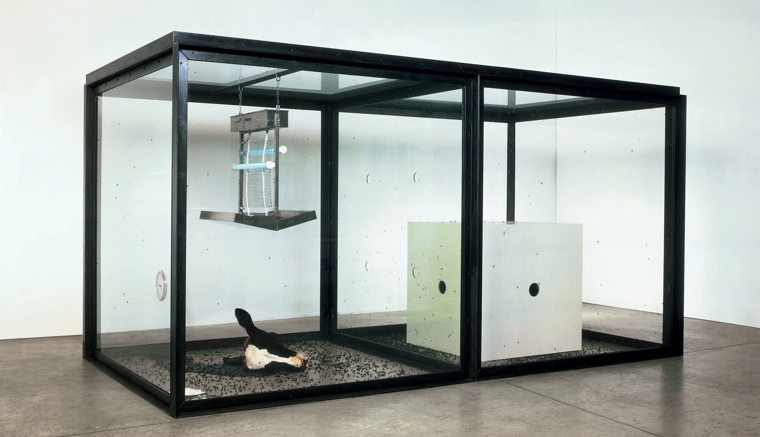 The first inkling I had that something interesting was afoot came with the exhibitions Gambler and Modern Medicine. I’ll never forget trekking to Building One, a vast disused biscuit factory in Bermondsey where in July 1990 Hirst was again showing with fellow alumni. There I came face to face with A Thousand Years, the first of his signature glass and steel tanks (pictured above). With its cool industrial elegance, from a distance it looks like a minimalist sculpture. At the time, minimalism was synonymous with high-art sophistication, but Hirst’s vitrine frames a disconcerting narrative. Minimalism prided itself on the purity of its abstraction (its distance from grimy reality) but A Thousand Years features a life and death struggle of epic proportions.
The first inkling I had that something interesting was afoot came with the exhibitions Gambler and Modern Medicine. I’ll never forget trekking to Building One, a vast disused biscuit factory in Bermondsey where in July 1990 Hirst was again showing with fellow alumni. There I came face to face with A Thousand Years, the first of his signature glass and steel tanks (pictured above). With its cool industrial elegance, from a distance it looks like a minimalist sculpture. At the time, minimalism was synonymous with high-art sophistication, but Hirst’s vitrine frames a disconcerting narrative. Minimalism prided itself on the purity of its abstraction (its distance from grimy reality) but A Thousand Years features a life and death struggle of epic proportions.
Bluebottles emerge from a hidden box of maggots and, attracted by the smell of a rotting cow’s head in the adjoining tank, fly through holes in the divide to feed, mate and lay their eggs. Meanwhile an insect-o-cutor randomly kills them, so that a pile of twitching corpses quickly builds up. “In warehouses and food stores such events are commonplace and unremarkable,” I would write in Time Out, “but, packaged as art and presented for contemplation, they take on sadistic overtones.”
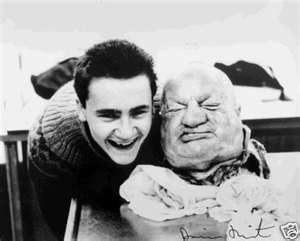 Fascinated but repelled, I wandered off to look at a medicine cabinet containing out-of-date drugs that would poison rather than cure anyone who swallowed them. I was drawn back to the tank in time to see the dealer, Karsten Schubert, leaping back and forth beside it with a demonic grin on his face, waving his arms to make the flies swarm! But I wasn’t there when Charles Saatchi arrived in a green Rolls-Royce and not only bought the work but offered to fund future projects.
Fascinated but repelled, I wandered off to look at a medicine cabinet containing out-of-date drugs that would poison rather than cure anyone who swallowed them. I was drawn back to the tank in time to see the dealer, Karsten Schubert, leaping back and forth beside it with a demonic grin on his face, waving his arms to make the flies swarm! But I wasn’t there when Charles Saatchi arrived in a green Rolls-Royce and not only bought the work but offered to fund future projects.
At the time, Hirst lived in a vile tower block in Brixton with broken lifts, graffitied walls and stairs stinking of piss – the kind of place where you fear for your life and contemplate suicide (pictured right, Damien Hirst with Dead Head, 1981). Perched on a disgusting sofa that looked as if it came from a skip, I interviewed him for the first time. He blurted out his answers in staccato bursts. “I‘d never been interviewed before,” he told me 20 years later, “and I remember being amazed by the idea of being able to say something that would appear in print.”
I’ve interviewed him many times since then and in the intervening years he has become more fluent and said many memorable things, such as: “Art is like holding a mirror up to life. It’s about finding new ways to redo old ideas, and there’s only one idea – Gauguin's 'Where do we come from? What are we? Where are we going?' People find it difficult to deal with the real world; a way around it is to allude to things through metaphor or symbols, as they do in advertising.”
The remark summarises almost his entire output and explains how the flies came about. "People need to feel distanced,” says Hirst. "You can look at a fly and think of a person."
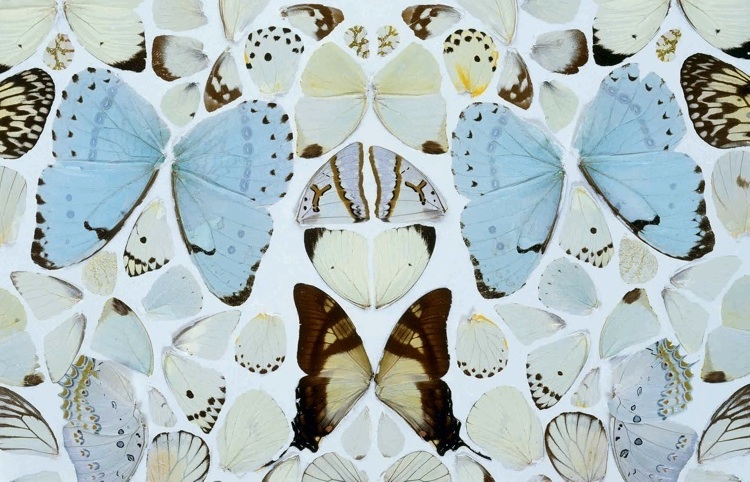 The following year he filled an empty shop in Woodstock Street, off Oxford Street, with live insects. Hatching from pupae attached to blank canvases, huge Malaysian butterflies floated about in tropical heat and humidity, sipped sugar water, mated and laid their eggs. In and Out of Love was far more seductive than A Thousand Years; whereas flies are associated with death and decay, butterflies bring to mind meadows, flowers and fresh air, and, for Victorians, they symbolised the soul ascending to heaven.
The following year he filled an empty shop in Woodstock Street, off Oxford Street, with live insects. Hatching from pupae attached to blank canvases, huge Malaysian butterflies floated about in tropical heat and humidity, sipped sugar water, mated and laid their eggs. In and Out of Love was far more seductive than A Thousand Years; whereas flies are associated with death and decay, butterflies bring to mind meadows, flowers and fresh air, and, for Victorians, they symbolised the soul ascending to heaven.
The mood was one of languid melancholy, until, that is, you went downstairs where the walls were lined with canvases with dead butterflies embedded in the monochrome paint (pictured above, Sympathy in White Major – Absolution 2, 2006, detail). On the table were ashtrays filled with cigarette butts, the foul-smelling and cancerous remnants of a party, perhaps. Hirst used to be a heavy smoker. "Every time I finish a cigarette, I think about death," he told me.
The installation offered two views of art – as a living installation or as dead objects. And as with the flies, it encouraged you to ponder the inter-relationship between life and death, as well as the meaning and quality of life.
Staring death in the face makes you aware that, to a predator, you are nothing but lunch
The fact that Hirst lived in such a dismal place must surely have influenced the idea, but the big themes which he has returned to again and again were implicit in his work from the start. I responded by writing: "Hirst alludes to heavy topics – health, meaningful living/living death, art as a live entity, the extinction of the individual and the species – with a brilliant, angst-free clarity. Powerful stuff."
The following January he shared a double bill with Bruce Nauman at the ICA and showed a tank that made direct reference to people. The Acquired Inability to Escape contains an office chair and table with nothing on it except a packet of fags, lighter and ashtray. You were invited mentally to occupy the chair and imagine being trapped inside this elegant, but stark, environment (qua executive suite or interview room). The claustrophobic space encourages contemplation of the rooms in which many spend their working lives and of the relationship between power and servitude. Does authority trap or free the person that wields it?
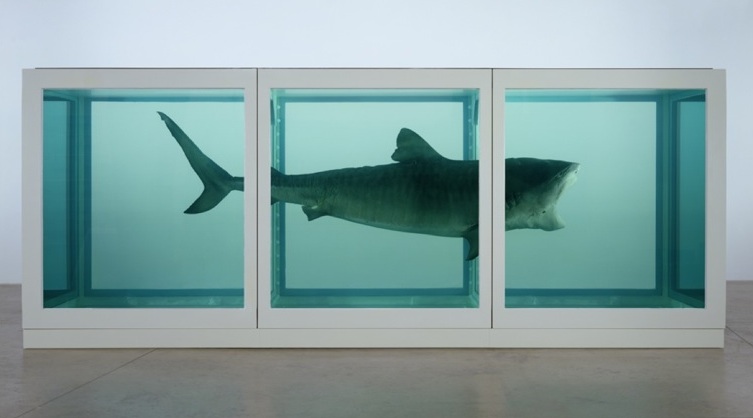 "Damien Hirst is undoubtedly one of the most interesting artists of the new generation," I wrote. "This is major work of museum quality; see it." It wasn’t until several months later when he showed at the Saatchi Gallery in St John’s Wood, that others took notice, though. For most people the story begins with Young British Artists I, the exhibition that gave the YBAs their name and, overnight, turned Hirst into an art star. His shark (The Physical Impossibility of Death in the Mind of Someone Living, 1991, pictured above) sparked a media feeding frenzy. Inveigled onto a chat show, I was confronted by an audience braying like a pack of hounds and a taxi driver who’d brought along some fish and chips and demanded to know why the pickled shark was art, if his fish supper wasn’t!
"Damien Hirst is undoubtedly one of the most interesting artists of the new generation," I wrote. "This is major work of museum quality; see it." It wasn’t until several months later when he showed at the Saatchi Gallery in St John’s Wood, that others took notice, though. For most people the story begins with Young British Artists I, the exhibition that gave the YBAs their name and, overnight, turned Hirst into an art star. His shark (The Physical Impossibility of Death in the Mind of Someone Living, 1991, pictured above) sparked a media feeding frenzy. Inveigled onto a chat show, I was confronted by an audience braying like a pack of hounds and a taxi driver who’d brought along some fish and chips and demanded to know why the pickled shark was art, if his fish supper wasn’t!
With breathtaking hypocrisy, the press accused Hirst of sensationalism – producing one-liners to appeal to Saatchi, the advertising mogul who commissioned the work. They ignored my catalogue essay, which explained why the tiger shark stuck in your mind long after the initial encounter.
Suspended in a tank of green formaldehyde, it looks as if it is swimming towards you, intent on biting your head off. Staring death in the face makes you aware that, to a predator, you are nothing but lunch. And as the realisation takes hold that we are simply part of the food chain, the arrogance that, since biblical times, has offered us dominion over other species is shaken to the core. It’s why we are so fascinated by and so fearful of major predators; they force us to rethink our place in the scheme of things. Hirst is notoriously obsessed with death. "I’ve thought about death every day since birth," he once told me.
 Hirst went on to confront one taboo after another. For instance, we prefer to ignore our internal organs, since they remind us of our vulnerability. Consisting of a pickled cow and calf sliced in half lengthwise, Mother and Child Divided (pictured above), which won him the Turner Prize in 1993, invites us to contemplate the body’s inner landscape, which proves to be intricate, complex and beautiful.
Hirst went on to confront one taboo after another. For instance, we prefer to ignore our internal organs, since they remind us of our vulnerability. Consisting of a pickled cow and calf sliced in half lengthwise, Mother and Child Divided (pictured above), which won him the Turner Prize in 1993, invites us to contemplate the body’s inner landscape, which proves to be intricate, complex and beautiful.
Pharmacy mimics a chemist's shop except that the drugs are arranged anatomically (those on the bottom shelf being for the feet and those on the top for the head). Like the early medicine cabinet it addresses our reliance on medicines to postpone death by keeping us healthy.
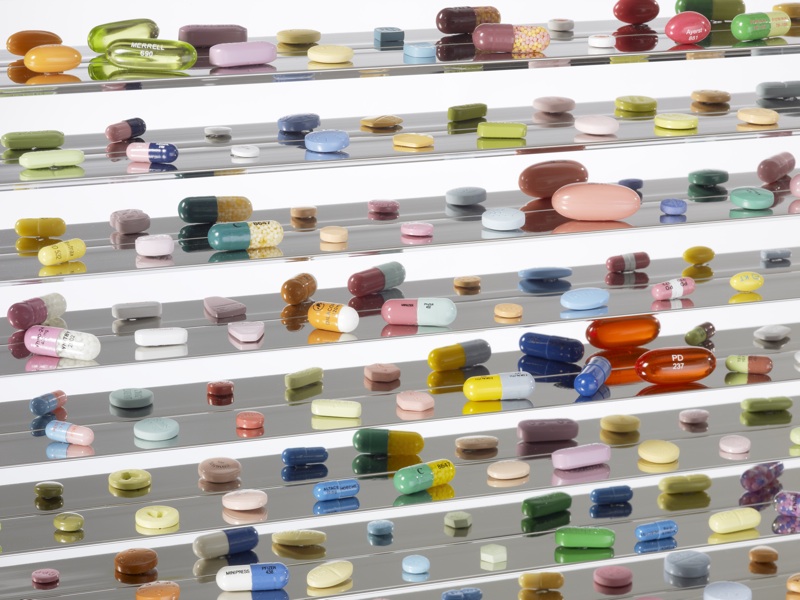 Hirst was notorious for his prodigious consumption of alcohol and illegal drugs. Consisting of hundreds of pills arranged in rows on stainless steel shelves, sculptures like Lullaby, The Seasons (2002) (pictured right), confront our dependence on illicit drugs to alleviate the stress or enliven the tedium of daily life. "Art is like medicine – it can heal," Hirst told me. "Yet I’ve always been amazed at how many people believe in medicine but don’t believe in art, without questioning either." Painted by assistants as an endless series, the spot paintings are named after legal and illicit drugs but, in my view, are essentially decorative. Hirst has never achieved anything in painting as radical or important as his sculptures.
Hirst was notorious for his prodigious consumption of alcohol and illegal drugs. Consisting of hundreds of pills arranged in rows on stainless steel shelves, sculptures like Lullaby, The Seasons (2002) (pictured right), confront our dependence on illicit drugs to alleviate the stress or enliven the tedium of daily life. "Art is like medicine – it can heal," Hirst told me. "Yet I’ve always been amazed at how many people believe in medicine but don’t believe in art, without questioning either." Painted by assistants as an endless series, the spot paintings are named after legal and illicit drugs but, in my view, are essentially decorative. Hirst has never achieved anything in painting as radical or important as his sculptures.
I believed in Hirst and in his conviction that art is more important than money; but that was before he encrusted a human skull with diamonds, in 2007, and called it For the Love of God (pictured below), as though daring us to rename it For the Love of Gold. Housed in the kind of display case found in jeweller’s shops, the glistening bauble is protected by security guards who make it impossible to ignore its monetary value (it sold to a consortium for a breathtaking £50 million) or its resemblance to expensive bling. One could argue that it functions as a memento mori – a reminder that life is short, and that “there are no pockets in a shroud”, as Hirst is fond of saying; but it feels like special pleading. For me, the skull embodies the union of art and money and is irredeemably corrupted by the liaison.
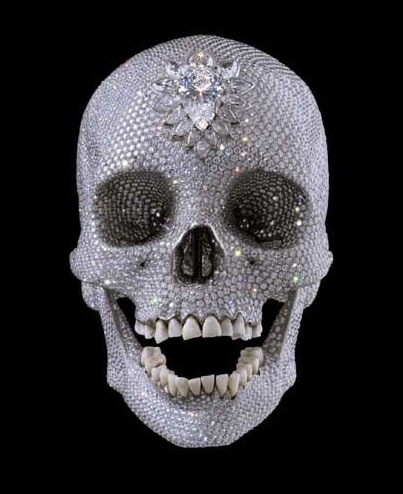 So am I finally linking hands with the cynics and disbelievers, then? Emphatically not. Hirst changed the face of Brit Art and, with the other YBAs, helped transform London from a cultural backwater into an international capital for contemporary art. And given the amazingly innovative work he produced in the 1990s and beyond, even if he churns out rubbish from now on (which would be sad, but unsurprising given the way success corrupts and softens), I’d still argue that he is by far the most important artist of his generation.
So am I finally linking hands with the cynics and disbelievers, then? Emphatically not. Hirst changed the face of Brit Art and, with the other YBAs, helped transform London from a cultural backwater into an international capital for contemporary art. And given the amazingly innovative work he produced in the 1990s and beyond, even if he churns out rubbish from now on (which would be sad, but unsurprising given the way success corrupts and softens), I’d still argue that he is by far the most important artist of his generation.
I’ll be going to Tate Modern neither to worship nor denounce, but with an open mind – hoping against hope that the work is still capable of generating the excitement I felt when I first saw and wrote about it.
- Damien Hirst at Tate Modern from 4 April until 9 September
- Sarah Kent is the author of Shark-Infested Waters: The Saatchi Collection of British Art in the 90s